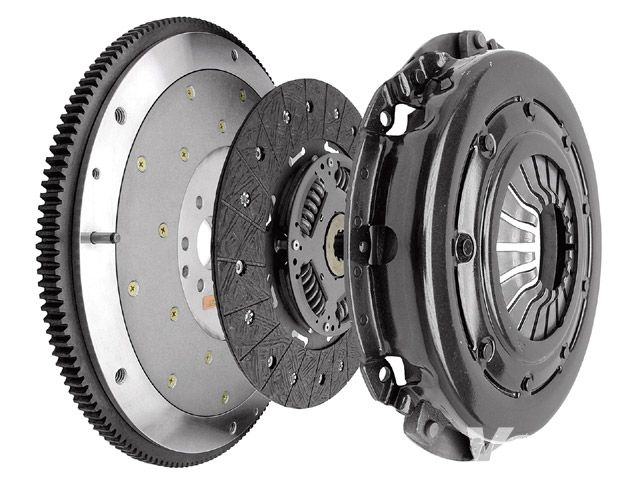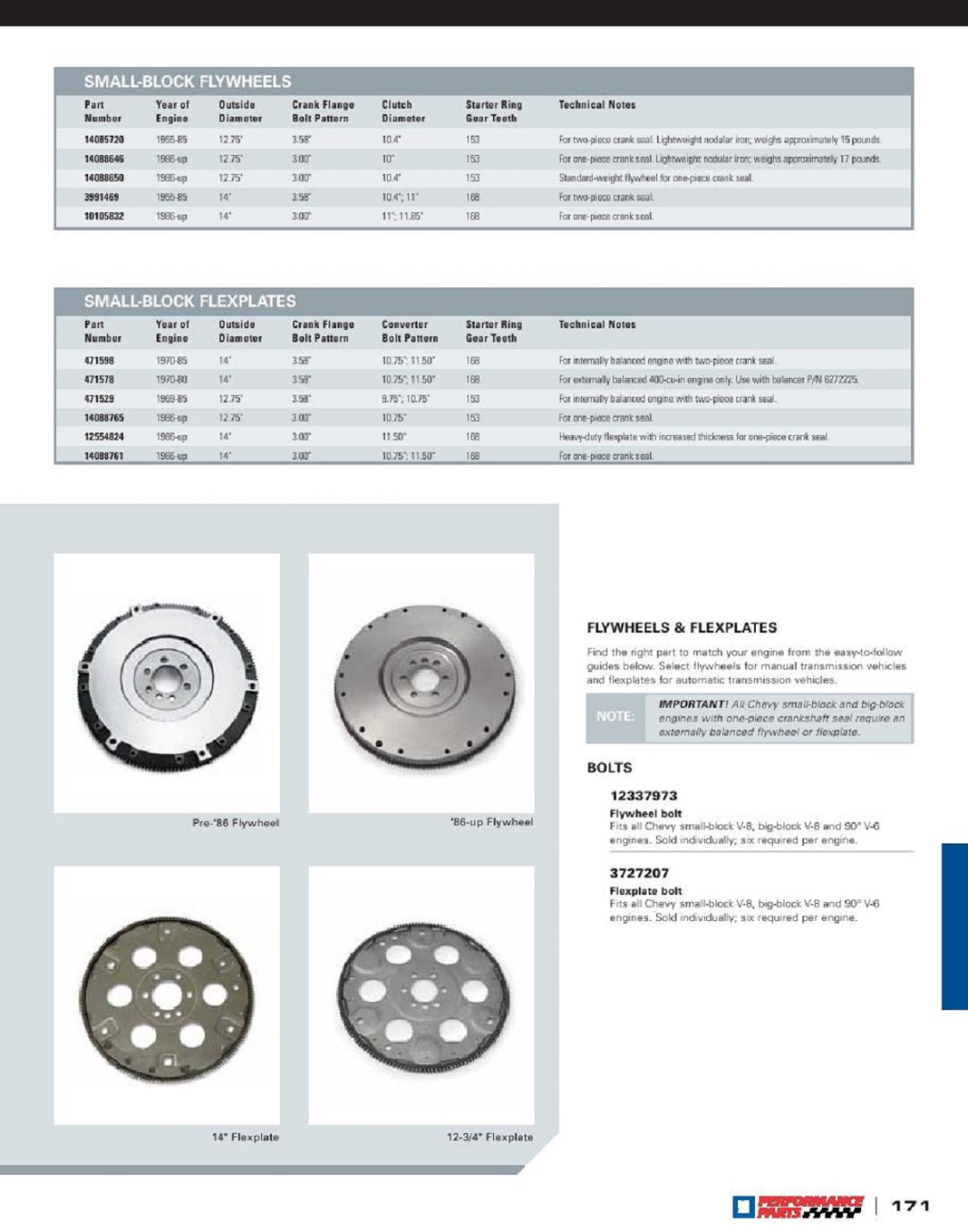selecting a flywheel, can be rather difficult for newer guys as most of them want to get
something like (THE RACERS USE)
and that can be a BIG mistake,
ESPECIALLY on a typical 3500 lb street car, and depending on the application,
for a street car you'll rarely find that a steel flywheel in the 30lb-40 lb range is a bad choice,
youll see guys suggest an auto trans with a flexplate is much lighter in weight but they ignore the converter and fluid weight thats easily 30-40 lbs
keep in mind nothing moves until the power reaches the tires/ground so your spinning the whole drive train, differential tires etc.
while a light weight aluminum flywheel almost always is the wrong choice on a street car.
but ID sure suggest getting an SFI rated flywheel and a BLOW PROOF BELL HOUSING AND CLUTCH ASSEMBLY
keep in mind heavier BILLET STEEL flywheels absorb heat more effectively and are usually far easier to balance and less prone to warping or cracking,
than either cast iron, which has a bad habit of cracking and flying apart at high stress and rpm levels or aluminum that tends to warp or have the surface mar under stress/heat loads.
you'll want to get the correct diam. (on a Chevy that's usually 168 tooth diam. but can occasionally be the smaller 153 tooth diam. and get a flywheel that's balanced (INTERNALLY OR EXTERNALLY) to match your application.
there's also one piece and two piece rear seals, and clutch bolt patterns matching 10".10.4", 11" clutches and both sbc and BBC designs, so shop carefully, and ask lots of questions.
IF YOUR THINKING ABOUT running a stock flex plate of flywheel, DON,T!, ESPECIALLY if the flex plate or flywheel weight looks poorly welded or loose... most stock components won,t hold up to racing stress levels forever, and you could easily have a clutch or flywheel self destruct at high rpms with catastrophic results.
buy a new SFI rated flywheel or flex plate, your chances of correctly welding it indexed and weighted correctly in relation to the cranks needs to balance the assembly are LOW at best, retaining your FEET is a higher priority, adding a blow proof Lakewood scatter shield or trans blanket would be a good idea, that weight could have removed your FEET if it came off at just the wrong time and angle at 6000rpm, Ive seen OEM CAST IRON,flywheels take out the dash, windshield and floor when they shatter on a high rpm shift
http://www.summitracing.com/parts/arp-2 ... /overview/
2807
http://www.summitracing.com/parts/arp-3 ... /overview/
2801
be sure the flywheel mounting bolts extend fully thru the crank flange threads, after securely locking the flywheel to the crank flange, but don,t extend much further than the flange outer surface facing the block
http://www.gmpartsdirect.com/performanc ... D=913.html
http://www.ramclutches.com/Products/flywheel_apps.htm
http://www.prwonlinestore.com/chevy_10.aspx
http://store.summitracing.com/egnsearch ... wordSearch
http://store.summitracing.com/egnsearch ... wordSearch
http://store.summitracing.com/egnsearch ... wordSearch
read these also
viewtopic.php?f=71&t=584&p=757&hilit=+bellhousing#p757
viewtopic.php?f=71&t=447&p=921&hilit=+clutch#p921
watch this (found on youtube)
http://www.youtube.com/watch?v=tDbrvUtN ... r_embedded
something like (THE RACERS USE)
and that can be a BIG mistake,
ESPECIALLY on a typical 3500 lb street car, and depending on the application,
for a street car you'll rarely find that a steel flywheel in the 30lb-40 lb range is a bad choice,
youll see guys suggest an auto trans with a flexplate is much lighter in weight but they ignore the converter and fluid weight thats easily 30-40 lbs
keep in mind nothing moves until the power reaches the tires/ground so your spinning the whole drive train, differential tires etc.
while a light weight aluminum flywheel almost always is the wrong choice on a street car.
but ID sure suggest getting an SFI rated flywheel and a BLOW PROOF BELL HOUSING AND CLUTCH ASSEMBLY
keep in mind heavier BILLET STEEL flywheels absorb heat more effectively and are usually far easier to balance and less prone to warping or cracking,
than either cast iron, which has a bad habit of cracking and flying apart at high stress and rpm levels or aluminum that tends to warp or have the surface mar under stress/heat loads.
you'll want to get the correct diam. (on a Chevy that's usually 168 tooth diam. but can occasionally be the smaller 153 tooth diam. and get a flywheel that's balanced (INTERNALLY OR EXTERNALLY) to match your application.
there's also one piece and two piece rear seals, and clutch bolt patterns matching 10".10.4", 11" clutches and both sbc and BBC designs, so shop carefully, and ask lots of questions.
IF YOUR THINKING ABOUT running a stock flex plate of flywheel, DON,T!, ESPECIALLY if the flex plate or flywheel weight looks poorly welded or loose... most stock components won,t hold up to racing stress levels forever, and you could easily have a clutch or flywheel self destruct at high rpms with catastrophic results.
buy a new SFI rated flywheel or flex plate, your chances of correctly welding it indexed and weighted correctly in relation to the cranks needs to balance the assembly are LOW at best, retaining your FEET is a higher priority, adding a blow proof Lakewood scatter shield or trans blanket would be a good idea, that weight could have removed your FEET if it came off at just the wrong time and angle at 6000rpm, Ive seen OEM CAST IRON,flywheels take out the dash, windshield and floor when they shatter on a high rpm shift
http://www.summitracing.com/parts/arp-2 ... /overview/
2807
http://www.summitracing.com/parts/arp-3 ... /overview/
2801
be sure the flywheel mounting bolts extend fully thru the crank flange threads, after securely locking the flywheel to the crank flange, but don,t extend much further than the flange outer surface facing the block
http://www.gmpartsdirect.com/performanc ... D=913.html
http://www.ramclutches.com/Products/flywheel_apps.htm
http://www.prwonlinestore.com/chevy_10.aspx
http://store.summitracing.com/egnsearch ... wordSearch
http://store.summitracing.com/egnsearch ... wordSearch
http://store.summitracing.com/egnsearch ... wordSearch
read these also
viewtopic.php?f=71&t=584&p=757&hilit=+bellhousing#p757
viewtopic.php?f=71&t=447&p=921&hilit=+clutch#p921
watch this (found on youtube)
http://www.youtube.com/watch?v=tDbrvUtN ... r_embedded
Last edited by a moderator:


